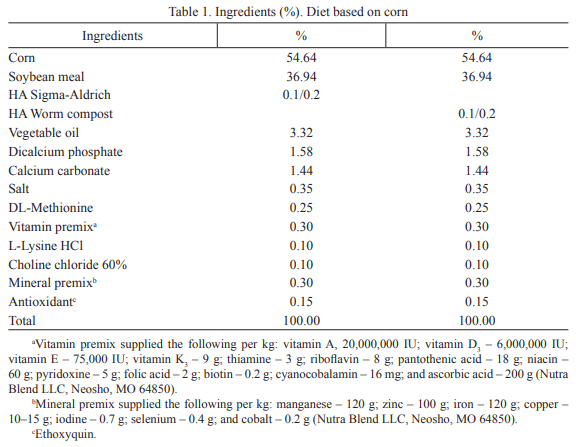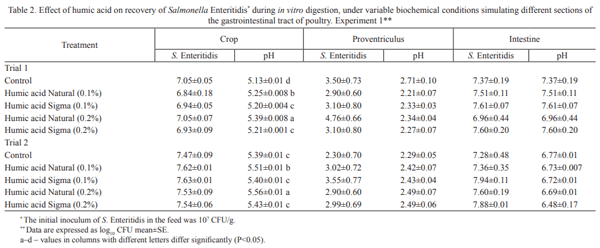Humic acids (HA) are a principal component of humic substances in organic constituents of soil, compost and coal; however, HA are also an important organic component in streams, lakes, and oceans (Lehmann and Kleber, 2015). Humic acids are produced by biodegradation of organic matter, hence they are a complex mixture of many different acids containing carboxyl and phenolate groups (Pandey et al., 2000). Therefore, HA behaves as a di- or tribasic acid and can interact with ions forming humic colloids (Chen and Elimelech, 2007). For centuries, HA have been used as a soil supplement in agriculture, and in humans as nutritional supplement (Peña-Méndez et al., 2005). Due to their heavy metal-binding abilities HA have been used to remove heavy metals from wastewater (Vaughan and MacDonald, 1976). In poultry, several studies have indicated that HA also have adsorbent mycotoxin capacity (van Rensburg et al., 2006; Arafat et al., 2017). Other studies suggest that HA used with proper nutritional management and biosecurity practices, improve intestinal integrity and performance in poultry (Karaoglu et al., 2004; Ji et al., 2006; Ipek et al., 2008; Gomez-Rosales and Angeles, 2015). Nevertheless, these benefits in animal performance are poorly understood. Humic acid has been used as an antidiarrheal, analgesic, immunostimulatory, and antimicrobial agent in veterinary practices in Europe (EMEA, 1999). In an old study, it was found that HA extracted from different soils and two synthetic HA showed antimicrobial activity against many human pathogenic bacteria such as St. epidermidis, S. aureus, Str. pyogenes, S. typhimurium, Prot. vulgaris, Ent. cloacae, Ps. aeruginosa and C. albicans (Ansorg and Rochus, 1978). In a recent report, it was observed that peat and coal HA showed a complete growth inhibition against St. aureus and Candida, and a decrease in the number of colonies from 78–80% in E. coli and from 58–70% in S. Enteritidis (Yarkova, 2011). It has been also speculated that HA stabilize the intestinal flora, and thus, ensure an improved utilization of nutrients in animal feed (Islam et al., 2005). Hence, the purpose of this study was to evaluate the effects of HA on recovery of Salmonella enterica serovar Enteritidis in an in vitro digestive system and intestinal colonization in neonate broiler chickens.
Material and methods
Humic acid
Humic acid from Sigma-Aldrich (catalog no. 53680) was used only in the in vitro digestive system to compare its effect on the recovery of S. Enteritidis with a natural source of HA. The isolation and extraction of HA from worm compost was performed as described by Stevenson (1982). For the alkaline extraction process of HA, sodium hydroxide (0.1M NaOH) was used in a ratio of 5 parts of NaOH to one part of compound (g/mL), allowed to stand for 24 h at room temperature, filtering in a 125 μm mesh and adding 10% sulfuric acid (H2 SO4 ), rectifying a pH of 2. The solids and liquids were separated by decantation. The solid fraction (HA) was washed 2 times with distilled water to remove sulfuric acid residues, and between each wash, it was centrifuged for 20 min at 5000 rpm. In a roto-evaporator the sample was desiccated at 60°C until it had a gel consistency. Finally, it was dried in an oven at 60°C. The result was a yellow-brown powder with a pH of 7 to 8.
Bacterial strain and culture conditions
The organism used in all experiments was a poultry isolate of Salmonella enterica serovar Enteritidis, bacteriophage type 13A, obtained from the USDA National Veterinary Services Laboratory, Ames, IA. This isolate was resistant to 25 µg/mL of novobiocin (NO, catalog no. N-1628, Sigma) and was selected for resistance to 20 µg/mL of nalidixic acid (NA, catalog no. N-4382, Sigma) in our laboratory. For the present studies, 100 µL of S. Enteritidis from a frozen aliquot was added to 10 mL of tryptic soy broth (catalog no. 22092, Sigma) and incubated at 37°C for 8 h, and passed three times every 8 h to ensure that all bacteria were in log phase. Post-incubation, bacterial cells were washed 3 times with sterile 0.9% saline by centrifugation at 1,864 × g for 10 min, reconstituted in saline, quantified by densitometry with a spectrophotometer (Spectronic 20D+, Spectronic Instruments Thermo Scientific), and diluted to an approximate concentration of 108 CFU per milliliter. Concentrations of S. Enteritidis were further verified by serial dilution and plating on brilliant green agar (BGA, catalog no. 70134, Sigma) with NO and NA for enumeration of actual CFU used to challenge the chickens.
Experiment 1. In vitro digestion model
Experiment 1 consisted of two independent in vitro trials. In each trial, all the steps of the in vitro digestion model were performed by quintuplicate at 40°C to simulate poultry body temperature according to previous publications with minor modifications (Annett et al., 2002; Latorre et al., 2015). In this experiment, two diets with two sources of HA, from commercial (Sigma) or natural extraction were tested at 0.1% and 0.2% inoculated with 107 CFU/tube of SE (Table 1). Briefly, for all the gastrointestinal compartments simulated during the in vitro digestion model, a BOD incubator (Biochemical oxygen demand incubator, model 2020, VWR, Houston, TX, USA) customized with an orbital shaker (Standard orbital shaker, model 3500, VWR, Houston, TX, USA) was used for mixing the feed content in the experimental tubes at 19 rpm. Additionally, all tube samples were held in a 30 degrees inclination position to facilitate proper blending of feed particles and the enzyme solutions incorporated throughout the assay. The first gastrointestinal compartment simulated was the crop, where 5 g of feed and 10 ml of 0.03 M hydrochloric acid (HCL, catalog no. HX0607-2, EMD Millipore corporation, Billerica, MA, USA) were placed in 50 mL polypropylene centrifuge tubes and mixed vigorously reaching a pH value around 5.20, next the tubes were incubated for 30 min. The second gastrointestinal compartment simulated was the proventriculus, where 3,000 U of pepsin per g of feed were used (catalog no. P700, Sigma-Aldrich, St Louis, MO, USA) and 2.5 ml of 1.5 M HCl were added to each of the tubes, reaching a pH between 1.4 and 2.00, then all tubes were incubated for 45 min. The third and final gastrointestinal compartment simulated was the intestinal section. In this case, 6.84 mg of 8 x pancreatin (catalog no. P7545, Sigma-Aldrich, St Louis, MO, USA) were used per g of feed and included in 6.5 ml of 1.0 M sodium bicarbonate (NaHCO3 , catalog no. S6014, Sigma-Aldrich, St Louis, MO, USA), the pH ranged between 6.4 and 6.8, and all tube samples were incubated for 2 h. The complete in vitro digestion process took 3 h and 15 min. After the incubation time in each compartment, a sample was collected to enumerate S. Enteritidis.

Experiment 2. Animal source, diets, and experimental design
One-day-old male Cobb-Vantress broiler chickens (Fayetteville, AR, USA) were neck-tagged, weighed and randomly allocated to one of two groups (n=25 chickens), with or without 0.2% of isolated HA from worm compost, and placed in heated brooder batteries with a controlled age-appropriate environment. Chicks had ad libitum access to water and feed for 10 days. The experimental diet was formulated to approximate the nutritional requirements of broiler chickens as recommended by the National Research Council (1994), and adjusted to breeder’s recommendations (Cobb-Vantress Inc., 2015). No antibiotics were added to the diet (Table 1). All animal handling procedures complied with Institutional Animal Care and Use Committee (IACUC) at the University of Arkansas, Fayetteville. Specifically, the IACUC approved this study under the protocol #15006. Chickens were orally gavaged with 106 CFU of S. Enteritidis alive per chicken at 10-d old. Twenty-four h post challenge, all chickens were euthanized and bled (femoral vein) to obtain serum for FITC-d determination. A section of the middle ileum was removed to obtain total concentration of IgA. Ceca-cecal tonsils were removed to evaluate Salmonella recovery as described below. A small number of chicks (n=10) were humanely killed upon arrival with CO2 asphyxiation. Ceca-cecal tonsils, liver and spleen were aseptically cultured in tetrathionate enrichment broth (catalog no. 210420, Becton Dickinson, Sparks, MD). Enriched samples were confirmed negative for Salmonella by streak plating the samples on Xylose Lysine Tergitol-4 (XLT-4, catalog no. 223410, BD Difco™) selective media.
Salmonella recovery
Ceca-cecal tonsils (CCT) were homogenized and diluted with saline (1:4 by wt/ vol) and ten-fold dilutions were plated on BGA with NO and NA, incubated at 37°C for 24 h to enumerate total S. Enteritidis colony forming units. However, in both trials of experiment 1, following plating to enumerate total SE, the CCT samples were enriched in double strength tetrathionate enrichment broth and further incubated at 37°C for 24 h to enrich. Following this, enrichment samples were plated on BGA with NO and NA and incubated at 37°C for 24 h to confirm presence/absence of typical lactose-negative colonies of Salmonella.
Enumeration of bacteria
Whole duodenum, ileum, and both ceca were aseptically removed and separated into sterile bags and homogenized. Samples were weighed and 1:4 wt/vol dilutions were made with sterile 0.9% saline. Ten-fold dilutions of each sample, from each group were made in a sterile 96 well Bacti flat bottom plate and the diluted samples were plated on two different plates of medium to evaluate total number of lactic acid bacteria (LAB) in Man Rogosa Sharpe (MRS Agar VWR Cat. No. 90004-084 Suwanee, GA 30024) or total Gram-negative bacteria in MacConkey Agar (VWR Cat. No. 89429–342 Suwanee, GA 30024).
Serum determination of FITC-d leakage
Intestinal leakage of fluorescein isothiocyanate dextran (FITC-d) (MW 3-5 KDa; Sigma-Aldrich Co., St. Louis, MO) and the measurement of its serum concentration as a marker of paracellular transport and mucosal barrier dysfunction (Yan et al., 2009; Baxter et al., 2017). At 24 h, post S. Enteritidis challenge, chickens in all groups were given an oral gavage dose of FITC-d (8.32 mg/kg). Following 1 h, they were euthanized and blood samples were collected from the femoral vein kept at room temperature for 3 h and centrifuged (500 x g for 15 min) to separate the serum from the red blood cells. FITC-d levels of diluted serum samples (1:5 PBS) were measured at excitation wavelength of 485 nm, gain 40 and emission wavelength of 528 nm with a Synergy HT, Multi-mode microplate fluorescence reader (BioTek Instruments, Inc., Vermont, USA). Fluorescence measured was then compared to a standard curve with known FITC-d concentrations. Gut leakage for each bird was reported as ng of FITC-d/mL of serum (Baxter et al., 2017).
Enzyme-linked immunosorbent assay for total IgA levels
An indirect ELISA was performed to quantify IgA as described previously (Merino-Guzmán et al., 2017). The commercial chicken IgA ELISA quantitation set (Cat. E30-103, Bethyl Laboratories Inc. Montgomery, TX 77356) was used according to the manufacturer’s instructions.
Data and statistical analysis
Log10 CFU/g of S. Enteritidis, pH, body weight (BW), body weight gain (BWG), total intestinal IgA and serum FITC-d concentration were subjected to analysis of variance as a completely randomized design, using the General Linear Models procedure of SAS (SAS Institute, 2002). Significant differences among the means were determined by Duncan’s multiple-range test at P<0.05. The enrichment data were expressed as positive/total chickens (%), and the percent recovery of SE was compared using the Chi-Squared test of independence, testing all possible combinations to determine the significance (P<0.05).
Results
Table 2 summarizes the results of the effect of HA on recovery of SE during in vitro digestion, under variable biochemical conditions simulating different sections of the gastrointestinal tract of poultry in two independent trials of experiment 1. In both trials, neither concentration of 0.1% or 0.2% of natural HA or HA from Sigma were able to reduce the recovery of S. Enteritidis in any of the simulated compartments of the in vitro digestive model (P>0.05). Similarly, no significant differences in pH were observed in proventriculus or intestine in both trials between control and treated groups. However, a significant reduction on pH in the crop compartment was observed for both concentrations of commercial or natural HA when compared with the control non-treated group. Interestingly, with the supplementation of both HA and both concentrations evaluated, a tendency (P=0.07) to increase the numbers of S. Enteritidis was observed in the intestine compartment, and this increase was associated with a similar tendency (P=0.07) of higher pH when compared with control non-treated group (Table 2).

Table 3 shows the results of the evaluation of BW and BWG in chickens consuming a corn-based diet with or without inclusion of 0.2% of natural HA of experiment 2. No significant differences were observed in BW or BWG between control and treated chickens at day 10 of age (Table 3).
The results of the evaluation of intestinal IgA, serum FITC-d and bacterial counts in ceca of 10-day-old broiler chickens treated with or without 0.2% natural HA and challenged with S. Enteritidis of experiment 2 are summarized in Table 4. No significant differences in any of the variables were observed between control and treated chickens (Table 4).
Discussion
The biodegradation product of organic matter, the compost, has been used in agriculture for centuries, as fertilizer and soil amendment (Lehmann and Kleber, 2015). Modern composting includes several meticulous steps that include the addition of water, air, and carbon- and nitrogen-rich materials to the organic matter to be composted (Peña-Méndez et al., 2005). In the process, eukaryotes (worms and fungi) as well as prokaryotes (aerobic bacteria) further break up the organic matter (Gomez-Rosales and Angeles, 2015). Some of the end chemical products are carbon dioxide and ammonium, which is an important source of nitrogen for plants. Other important nutrients such as humus or HA are also produced during composting of organic matter. In soil science, humus (from the Latin humus: earth) is a fraction of soil organic matter and represents the majority density of soil and contributes to moisture and nutrient retention. Hence, humus contains most of the nutrients of the soil. However, decomposition products of organic matter associated with other minerals make it difficult to isolate and characterize soil organic constituents (Peña-Méndez et al., 2005). Back in the 18th century, chemists used alkaline extractions to isolate some organic constituents present in soil and the substances isolated were identified as 'humic acid', 'fulvic acid', and 'humin' (Peña-Méndez et al., 2005; Lehmann and Kleber, 2015). Interestingly, in spite of the scientific and accurate evidence of 'humification', the concept persists in the current literature and textbooks. Nonetheless, humic substances are still in the main area of interest of soil scientists, as well as researchers in other areas of basic and applied science (Islam et al., 2005; Klocking and Helbig, 2005; Peña-Méndez et al., 2005). Several procedures have been proposed for the extraction of HA using alkaline solvents, chelating agents, organic solvents and aqueous saline solutions (Stevenson, 1982; Baglieri et al., 2007). From these, alkaline solvents remain the most efficient and most widely used (Baglieri et al., 2007).
Humic acid has been used as an antidiarrheal, analgesic, immunostimulatory, and antimicrobial agent in veterinary practices in Europe (EMEA, 1999). Furthermore, due to their adsorbent capacity, HA have been used to reduce mycotoxicosis (van Rensburg et al., 2006; Ghahri et al., 2010; Arafat et al., 2017) and to reduce ammonia emissions from pig manure (Ji et al., 2006; Písaríková et al., 2010). In poultry, several investigators have reported that HA improves performance, gut morphology, carcass traits and meat quality and reduces social stress (Karaoglu et al., 2004; Cetin et al., 2011; Gomez-Rosales and Angeles, 2015). As far as we are aware, this is the first study trying to evaluate the effect of HA extracted from a worm compost on S. Enteritidis recovery in vitro or in vivo. In the present study, the supplementation of 0.1% or 0.2% of a commercial HA product from Sigma-Aldrich or a natural HA product extracted from worm compost in an in vitro digestive model, did not affect the numbers of S. Enteritidis recovered in the three compartments evaluated. Interestingly, a numerical tendency to increase the recovery of S. Enteritidis was observed in those groups supplemented with commercial or natural HA at both concentrations when compared with control non-treated group, and this increase was associated with a numerical increase in pH in the intestine compartment. These findings were confirmed when chickens received 0.2% of HA in the diet for 10 days prior to S. Enteritidis administration, HA had no effect on S. Enteritidis recovery from CCT 24 h after S. Enteritidis challenge. These results do not agree with previous reports based on in vitro and in vivo assays. In the study of Ansorg and Rochus (1978) it was found that HA extracted from different soils and two synthetic HA showed antimicrobial activity against many human pathogenic bacteria such as St. epidermidis, S. aureus, Str. pyogenes, S. typhimurium, Prot. vulgaris, Ent. cloacae, Ps. aeruginosa and C. albicans. Yarkova (2011) observed that peat and coal HA showed complete growth inhibition of S. aureus and Candida, and a decrease in the number of colonies from 78–80% in E. coli and from 58–70% in S. Enteritidis. Aksu and Bozkurt (2009) fed broiler chickens diets supplemented with a commercial source of HA (Farmagulator Dry-Humic AcidTM) and found that the CFU of E. coli in the digesta of birds fed either a diet with antibiotic and diets with HA were significantly lower than in those given the control. Opposite to this, in the report of Jansen van Rensburg and Naude (2009), the coliforms and E. coli counts in the caecum were not affected by the addition of potassium humate in the drinking water of broilers; whereas Shermar et al. (1998) reported an increase between 10 to 100 times in the E. coli populations from birds receiving a commercial mined humate (Menefee HumateTM) compared to the control birds.
It has been also speculated that HA stabilize the intestinal flora, and thus, ensure an improved utilization of nutrients in animal feed (Islam et al., 2005). The results of the present study do not agree with the above suggestion because the total counts of LAB or total Gram negative bacteria isolated from the ceca (Experiment 2) were not different whether the diet was supplemented or not supplemented with HA, indicating that HA does not impact the numbers of gut microbiota. Our results are in agreement with the findings of Jansen van Rensburg and Naude (2009), in which the aerobic mesophiles, lactococci and lactobacilli counts in the caecum of broilers were not affected by the addition of potassium humate in the drinking water; but are opposite to the increased CFU of Lactobacilli reported in broilers supplemented with HA (Aksu and Bozkurt, 2009).
The supplementation of 0.2% of natural HA did not affect the concentration of total intestinal IgA (Table 4), which does not support the suggestion that HA has immunostimulant effects (EMEA, 1999; Klocking and Helbig, 2005). A positive effect on the antibody titres against Newcastle Disease Virus has been reported in broilers supplemented with HA (Aksu and Bozkurt, 2009; Kamel et al., 2015). In another study with broilers fed a commercial source of HA (Farmagulator) an increase in the antibody production against SRBC was reported (El-Husseiny et al., 2008). In addition, Jansen van Rensburg and Naude (2009), reported that the addition of potassium humate in the drinking water of broilers significantly inhibited the release of TNF-α, IL-1β, IL-6 and IL-10 by phytohaemaglutinin A stimulated mononuclear lymphocyte.
One of the proposed mechanisms of action of HA is related to the ability to create protective layers over the epithelial mucosal membrane of the digestive tract against the penetrations of toxic and other bacterial contaminated substances (Rath et al., 2002; Taklimi et al., 2012); however, the results of our study do not support this suggestion because the supplementation of HA did not affect the concentration of serum FITC-d in chicks used in Experiment 2 (Table 4). FITC-d is a large molecule (3–5 kDa), which does not usually leak through the intact gastrointestinal tract barrier. However, when there are conditions which disrupt the tight junctions between epithelial cells, the molecule can enter circulation, demonstrated by an increase in trans-mucosal permeability associated with chemically induced disruption of tight junctions by elevated serum levels of FITC-d after oral administration (Yan et al., 2009).
The lack of effects of HA on Salmonella recovery in the in vitro assay and on intestinal colonization, bacterial counts in ceca, intestinal IgA and serum FITC-d in broilers may have been due to differences in the dosage and chemical composition of HA (Ansorg and Rochus, 1978; Yarkova, 2011). In the present study, the HA dosages were chosen from the reports of Kocabagli et al. (2002) and Yoruk et al. (2004). Regarding the differences in chemical composition, it has been pointed out that HA with different characteristics such as chain length, side chain composition and origin (plant, soil, peat, and coal derived) can be found in commercial or purified sources of HA (Gomez-Rosales and Angeles, 2015).
In some of the studies reviewed above, different sources of HA were tested, such as HA extracted from different soils, peat and coal, a source of potassium humate, as well as commercial and synthetic HA; furthermore, different dosages in the in vitro and in vivo tests were used, which could have caused the differences in the response variables compared to our study, in that an extracted HA source from a worm compost was tested. It has also been suggested that responses to alternatives to antibiotic growth promoters may be greater in a more challenging environment (Ozturk et al., 2010, 2012) and that feed additives such as HA are not effective if there are no stress factors. Elucidation of the effects of HA under stress models as inducers of intestinal inflammation deserves further clarification.
It can be concluded that no effects of HA on recovery of Salmonella Enteritidis, in an in vitro digestive system and on intestinal colonization of Salmonella, bacterial counts in ceca, intestinal IgA and serum FITC-d in neonate broiler chickens were observed. Further studies to evaluate the effect of HA under feed restriction model as an inducer of intestinal inflammation are currently being conducted.
Acknowledgments
This research was supported by the Arkansas Bioscience Institute under the project: Development of an avian model for evaluation early enteric microbial colonization on the gastrointestinal tract and immune function.
This article was originally published in Annals of Animal Science, Vol. 18, No. 2 (2018) 387–399 DOI: 10.1515/aoas-2017-0037. This is an Open Access article distributed under a Creative Commons Attribution License. 

















.jpg&w=3840&q=75)